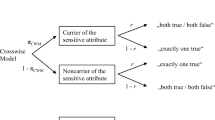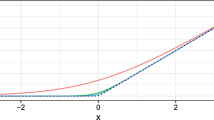Abstract
This study focuses on the uni-variate logistic regression model and the multi-variate analyzes when response variables are reliant on random response and multi-variate logistic regression in the form of an RR design, which is something that we look at for the first time. The research is divided into two sections. In the first part, we employ a single variable to express binary RR response variables. This is done during the first step of the logistic regression model. This model is referred to as a generalized linear model, and our GLM has useful characteristics such as the features of parameter estimates derived from the GLM standard (GLM). The second section of a multivariate logistic regression model incorporates response variables as one of its components. Two components of the model that have not previously been discussed will be explained by providing it in the format of (GLM) before: 1- This model contains useful properties of standard GLM, such as Properties of parametric estimates. 2- Standard GLM application can be used to test this model. This research shows how Common settings are possible in R and GLIM software and this ensures that logistic regression models may be evaluated with confidence for RR response variables. Also included are random variables to aid in investigating the link between different aspects of an individual's RR response, as well as the multi-variate logistic regression model that we developed to help accomplish just that.



Similar content being viewed by others
Data Availability Statement
This manuscript has associated data in a data repository. [Authors’ comment: The data will be available on request from the corresponding author.]
References
S.L. Warner, Randomized-response: a survey technique for eliminating evasive answer bias. J. Am. Stat. Assoc. 60, 63–69 (1965)
Z. Zhang, C. Luo, Z. Zhao, Application of probabilistic method in maximum tsunami height prediction considering stochastic seabed topography. Nat Hazards (Dordrecht) (2020). https://doi.org/10.1007/s11069-020-04283-3
Y. Zhang, Z. Pan, J. Yang, J. Chen, K. Chen, K. Yan, M. He, Study on the suppression mechanism of (NH4)2CO3 and SiC for polyethylene deflagration based on flame propagation and experimental analysis. Powder Technol. 399, 1 (2022). https://doi.org/10.1016/j.powtec.2022.117193
J. Chen, Q. Wang, J. Huang, X. Chen, Motorcycle ban and traffic safety: evidence from a quasi-experiment at Zhejiang, China. J. Adv. Transp. 2021, 1–13 (2021). https://doi.org/10.1155/2021/7552180
R. Shamsi, J. Manafian, S. Esmaeili, Ranking extreme efficient decision making units in stochastic DEA. Adv. Math. Models Appl. 7(2022), 38–43 (2022)
D.G. Horvitz, B.V. Shah, W.R. Simmons, The unrelated question randomized response model. In: Proceedings of the social statistics section. American Statistical Association 65–72 (1967)
J. Houston, A. Tran, A survey of tax evasion using the randomized response. Adv Tax 13, 69–94 (2001)
G.J.L.M. Lensvelt-Mulders, J.J. Hox, P.G.M. Van Der Heijden, How to improve the efficiency of randomised response designs? Qual. Quant. 39, 253–265 (2005)
F. Meng, A. Pang, X. Dong, C. Han, X. Sha, N. Jing, J. Na, H∞ optimal performance design of an unstable plant under bode integral constraint. Complexity (New York, N.Y.) (2018). https://doi.org/10.1155/2018/4942906
F. Meng, D. Wang, P. Yang, G. Xie, R. Cutberto, C. Romero-Meléndez, Application of sum of squares method in nonlinear H∞ control for satellite attitude maneuvers. Complexity (New York, N.Y.) (2019). https://doi.org/10.1155/2019/5124108
M.J.L.F. Cruyff, A. Van Den Hout, P.G.M. Van Der Heijden, U. Böckenholt, Log-linear randomized-response models taking self-protective response behavior into account. Sociol Methods Res 36, 266–282 (2007)
M.J.L.F. Cruyff, U. Böckenholt, P.G.M. van der Heijden, L.E. Frank, Chapter 18 - a review of regression procedures for randomized response data including uni-variate and multi-variate logistic regression the proportional odds model and item response model and self-Protective responses. Handb Stat 34, 287–315 (2016)
O.A. Ilhan, J. Manafian, H.M. Baskonus, M. Lakestani, Solitary wave solitons to one model in the shallow water waves. Eur. Phys. J. Plus 136(3), 258 (2021). https://doi.org/10.1140/epjp/s13360-021-01327-w
S. Pourghanbar, J. Manafian, M. Ranjbar, A. Aliyeva, Y.S. Gasimov, An efficient alternating direction explicit method for solving a nonlinear partial differential equation. Math. Probl. Eng. 2020, 9647416 (2020). https://doi.org/10.1155/2020/9647416
R. Shamsi, G.R. Jahanshahloo, M.R. Mozaffari, F.H. Lotfi, Centralized resource allocation with MOLP Structure. Indian J Sci Technol 7(9), 1297–1306 (2014). https://doi.org/10.17485/ijst/2014/v7i9.25
J.W. Yu, G.L. Tian, M.L. Tang, Two new models for survey sampling with sensitive characteristic: design and analysis. Metrika 67, 251–263 (2008)
M. Shamspour, M. Yunesian, A. Fotouhi, B. Jann, A. Rahimi-Movaghar, F. Asghari, A.A. Akhlaghi, Estimating the prevalence of illicit drug use among students using thecrosswise model. Subst. Use Misuse 49, 1303–1310 (2014)
S.H. Pier, F. Perrib, Estimating the proportion of non-heterosexuals in Taiwan using Christofides’ randomized response model: A comparison of different estimation methods. Soc. Sci. Res. 93, 102475 (January 2021)
S. Kost, O. Rheinbach, H. Schaebenb, Using logistic regression model selection towards interpretable machine learning in mineral prospectivity modeling. Geochemistry 81(4), 125826 (November 2021)
K.M. Ang, E.K. Seow, P.S. Fam, L.H. Cheng, Classification of edible bird’s nest samples using a logistic regression model through the mineral ratio approach. Food Control 137, 108921 (2022)
A.A.H. Ahmadini, A novel technique for parameter estimation in intuitionistic fuzzy logistic regression model. Ain Shams Eng. J. 13(1), 101518 (January 2022)
G.F. Glonek, P. McCullagh, Multivariate Logistic Models. J. R. Stat. Soc. Ser. B: Methodol. 57, 533–546 (1995)
B. Jann, J. Jerke, I. Krumpal, Asking sensitive questions using the crosswise model: an experimental survey measuring plagiarism. Public Opin. Q. 76, 49–32 (2012)
B.G. Greenberg, A.L.A. Abul-Ela, W.R. Simmons, D.G. Horvitz, The unrelated question RR model: theoretical framework. J. Am. Stat. Assoc. 64, 520–539 (1969)
Author information
Authors and Affiliations
Corresponding author
Rights and permissions
Springer Nature or its licensor holds exclusive rights to this article under a publishing agreement with the author(s) or other rightsholder(s); author self-archiving of the accepted manuscript version of this article is solely governed by the terms of such publishing agreement and applicable law.
About this article
Cite this article
Shamsi, R., Ghasami, S. Relationship between decision changes under the study of random response (RR) using the logistic regression model. Eur. Phys. J. Plus 137, 956 (2022). https://doi.org/10.1140/epjp/s13360-022-03088-6
Received:
Accepted:
Published:
DOI: https://doi.org/10.1140/epjp/s13360-022-03088-6




